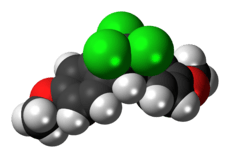Methoxychlor
 | |
 | |
| Names | |
|---|---|
| IUPAC name
1,1,1-Trichloro-2,2-bis(4-methoxyphenyl)ethane | |
| Other names
Methoxcide Dimethoxy-DDT Methoxy-DDT p,p'-Dimethoxydiphenyltrichloroethane | |
| Identifiers | |
| 72-43-5 | |
| 3D model (Jmol) | Interactive image |
| Abbreviations | DMDT |
| ChEBI | CHEBI:6842 |
| ChEMBL | ChEMBL362919 |
| ChemSpider | 3972 |
| ECHA InfoCard | 100.000.709 |
| KEGG | C11043 |
| PubChem | 4115 |
| UNII | RIA79UD69L |
| |
| |
| Properties | |
| C16H15Cl3O2 | |
| Molar mass | 345.65 g/mol |
| Appearance | Colorless to light-yellow crystals |
| Odor | Slight, fruity odor |
| Density | 1.41 g/cm3 (20°C)[1] |
| Melting point | 87 °C (189 °F; 360 K) |
| Boiling point | decomposes |
| 0.00001% (20°C)[1] | |
| Hazards | |
| Lethal dose or concentration (LD, LC): | |
| LD50 (median dose) |
5000 mg/kg (oral, rat) 1000 mg/kg (oral, mouse) >6000 mg/kg (oral, rabbit)[2] |
| US health exposure limits (NIOSH): | |
| PEL (Permissible) |
TWA 15 mg/m3[1] |
| REL (Recommended) |
Ca[1] |
| IDLH (Immediate danger) |
Ca [5000 mg/m3][1] |
| Except where otherwise noted, data are given for materials in their standard state (at 25 °C [77 °F], 100 kPa). | |
| | |
| Infobox references | |
Methoxychlor is a synthetic organochlorine used as an insecticide.
Usage
Methoxychlor is used to protect crops, ornamentals, livestock, and pets against fleas, mosquitoes, cockroaches, and other insects. It was intended to be a replacement for DDT, but has since been banned based on its acute toxicity, bioaccumulation, and endocrine disruption activity.[3]
The amount of methoxychlor in the environment changes seasonally due to its use in farming and foresting. It does not dissolve readily in water, so it is mixed with a petroleum-based fluid and sprayed, or used as a dust. Sprayed methoxychlor settles on the ground or in aquatic ecosystems, where it can be found in sediments.[4] Its degradation may take many months. Methoxychlor is ingested and absorbed by living organisms, and it accumulates in the food chain. Some metabolites may have unwanted side effects.
Banned
The use of methoxychlor as a pesticide was banned in the United States in 2003[5] and in the European Union in 2002.[6]
Human exposure
Human exposure to methoxychlor occurs via air, soil, and water,[7] primarily in people who work with the substance or who are exposed to air, soil, or water that has been contaminated. It is unknown how quickly and efficiently the substance is absorbed by humans who have been exposed to contaminated air or via skin contact.[7] In animal models, high doses can lead to neurotoxicity.[7] Some methoxychlor's metabolites have estrogenic effects in adult and developing animals before and after birth.[7] One studied metabolite is 2,2-bis(p-hydroxyphenyl)-1,1,1-trichloroethane (HPTE) which shows reproductive toxicity in an animal model by reducing testosterone biosynthesis.[8][9] Such effects adversely affect both the male and female reproductive systems. It is expected that this "could occur in humans" but has not been proven.[7] While one study has linked methoxychlor to the development of leukemia in humans, most studies in animals and humans have been negative, thus the EPA has determined that it is not classifiable as a carcinogen. The EPA indicates that levels above the maximum contaminant level of 40 ppb "cause" central nervous depression, diarrhea, damage to liver, kidney, and heart, and - by chronic exposure - growth retardation.[3]
Little information is available regarding effects on human pregnancy and children, but it is assumed from animals studies that methoxychlor crosses the placenta, and it has been detected in human milk[7] Exposure to children may be different than in adults because they tend to play on the ground, further, their reproductive system may be more sensitive to the effects of methoxychlor as an endocrine disruptor.
Food contamination may occur at low levels and it is recommended to wash all foods.[7] A number of hazardous waste sites are known to contain methoxychlor.
Maximum pesticide residue limits for the EU/UK are set at 0.01 mg/kg for oranges and 0.01 mg/kg for apples.
Labeling
The EPA lists methoxychlor as "a persistent, bioaccumulative, and toxic (PBT) chemical by the EPA Toxics Release Inventory (TRI) program",[3] and as such it is a waste minimization priority chemical.
Tradenames for methoxychlor include Chemform, Maralate, Methoxo, Methoxcide, Metox and Moxie.
See also
References
- 1 2 3 4 5 "NIOSH Pocket Guide to Chemical Hazards #0388". National Institute for Occupational Safety and Health (NIOSH).
- ↑ "Methoxychlor". Immediately Dangerous to Life and Health. National Institute for Occupational Safety and Health (NIOSH).
- 1 2 3 United States Environmental Protection Agency (2006-11-26). "Consumer Factsheet on: METHOXYCHLOR".
- ↑ Karickhoff; et al. "Sorption of Hyrdophobic Pollutants on Natural Sediments.". Water Research. 13: 241–248. doi:10.1016/0043-1354(79)90201-x.
- ↑ U.S. Environmental Protection Agency (June 30, 2004). "Methoxychlor Reregistration Eligibility Decision (RED) EPA Publication No. EPA 738-R-04-010". Retrieved 2009-10-02.
- ↑ European Union - DG SANCO. "EU Pesticides Database". Retrieved 2009-10-02.
- 1 2 3 4 5 6 7 ATSDR (September 2002). "Public Health Statement about Methoxychlor" (PDF)., accessed 08-22-2008
- ↑ Akingbemi BT, et al. (2000). "A Metabolite of Methoxychlor, 2,2-Bis(p-Hydroxyphenyl)-1,1,1-Trichloroethane, Reduces Testosterone Biosynthesis in Rat Leydig Cells Through Suppression of Steady-State Messenger Ribonucleic Acid Levels of the Cholesterol Side-Chain Cleavage Enzyme". Biology of Reproduction. 62: 571–578. doi:10.1095/biolreprod62.3.571.
- ↑ Cummings AW (1997). "Methoxychlor as a model for environmental estrogens.". Crit Rev Toxicol. 27 (4): 367–79. doi:10.3109/10408449709089899. PMID 9263644.
External links
- Methoxychlor in the Pesticide Properties DataBase (PPDB)
- CDC Report
- NIOSH Pocket Guide to Chemical Hazards
- EPA Report
- Extoxnet
- Pubertal Toxicity Study, 2003